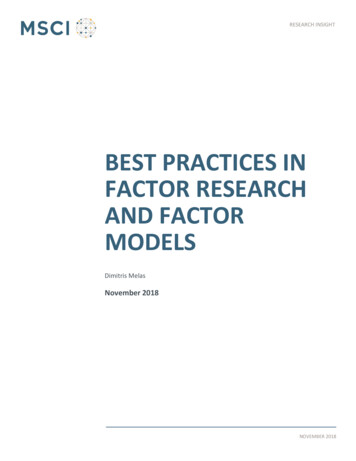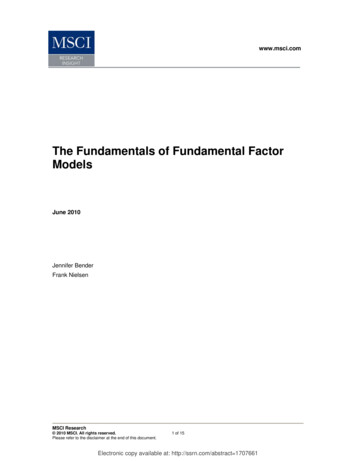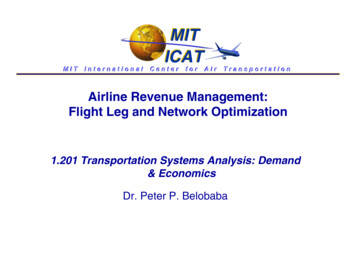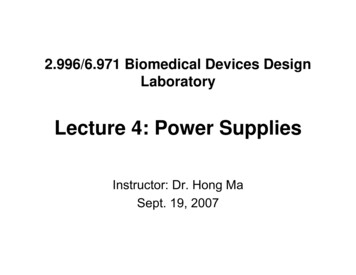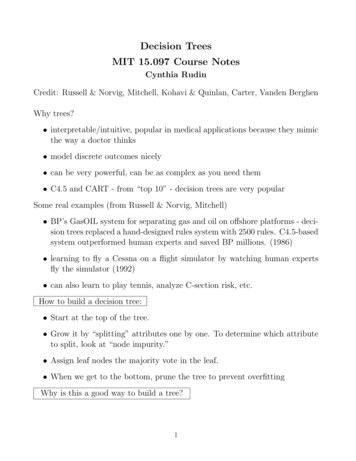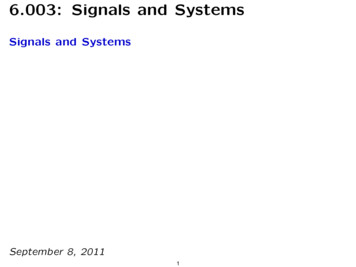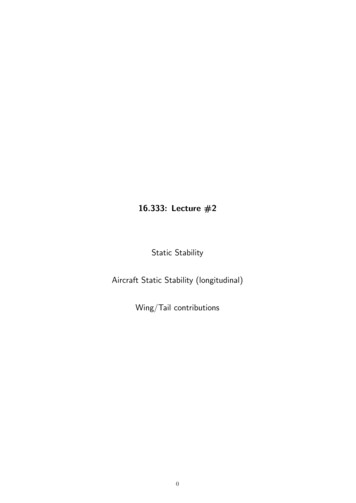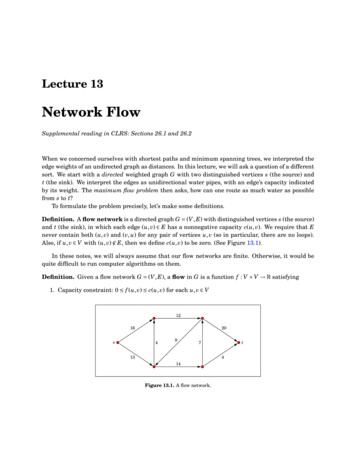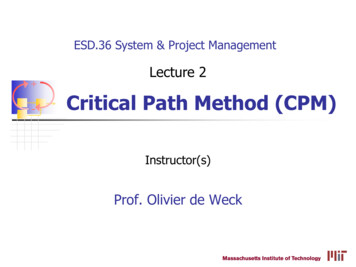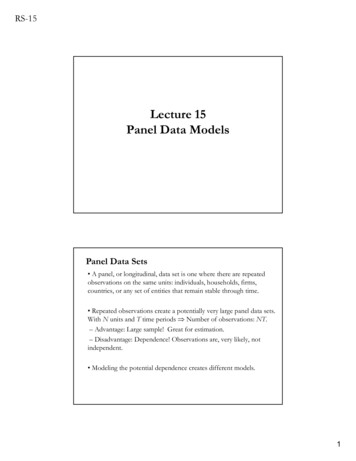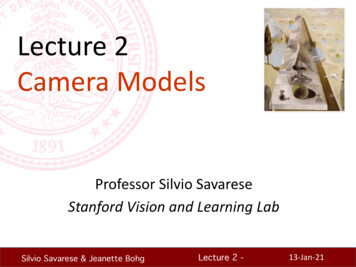
Transcription
Factor ModelsLecture 15: Factor ModelsMIT 18.S096Dr. KempthorneFall 2013MIT 18.S096Factor Models1
Factor ModelsLinear Factor ModelMacroeconomic Factor ModelsFundamental Factor ModelsStatistical Factor Models: Factor AnalysisPrincipal Components AnalysisStatistical Factor Models: Principal Factor MethodOutline1Factor ModelsLinear Factor ModelMacroeconomic Factor ModelsFundamental Factor ModelsStatistical Factor Models: Factor AnalysisPrincipal Components AnalysisStatistical Factor Models: Principal Factor MethodMIT 18.S096Factor Models2
Factor ModelsLinear Factor ModelMacroeconomic Factor ModelsFundamental Factor ModelsStatistical Factor Models: Factor AnalysisPrincipal Components AnalysisStatistical Factor Models: Principal Factor MethodLinear Factor ModelData:m assets/instruments/indexes: i 1, 2, . . . , mn time periods: t 1, 2, . . . , nm-variate random vector for each time period:xt (x1,t , x2,t , . . . , xm,t )0E.g., returns on m stocks/futures/currencies;interest-rate yields on m US Treasury instruments.Factor Modelxi,t αi β1,i f1,t β2,i f2,t · · · βk,i fk,t i,t αi β 0i f t i,twhereαi : intercept of asset if t (f1,t , f2,t , . . . , fK ,t )0 : common factor variables at period t (constant over i)β i (β1,i , . . . , βK ,i )0 : factor loadings of asset i (constant over t) i,t : the specific factor of asset i at period t.MIT 18.S096Factor Models3
Factor ModelsLinear Factor ModelMacroeconomic Factor ModelsFundamental Factor ModelsStatistical Factor Models: Factor AnalysisPrincipal Components AnalysisStatistical Factor Models: Principal Factor MethodLinear Factor ModelLinear Factor Model: Cross-Sectional Regressionsxt α Bf t t ,for each t {1, 2 . . . , T }, where 0 α1β1 1,t α2 β 02 2,t α . (m 1); B . βi,k (m K ); t . (m 1) . . . 0αmβm m,tα and B are the same for all t.{f t } is (K variate) covariance stationary I (0) withE [f t ] µfCov [f t ] E [(f t µf )(f t µf )0 ] Ωf{ t } is m-variate white noise with:E [ t ] 0mCov [ t ] E [ t 0t ] ΨCov [ t , t 0 ] E [ t 0t 0 ] 0 t 6 t 02 ) whereΨ is the (m m) diagonal matrix with entries (σ12 , σ22 , . . . , σmσi2 var ( i,t ), the variance of the ith asset specific factor.The two processes {f t } and { t } have null cross-covariances:0MITE [(f18.S0960 0Modelst µf )( tFactorm) ] 4
Factor ModelsLinear Factor ModelMacroeconomic Factor ModelsFundamental Factor ModelsStatistical Factor Models: Factor AnalysisPrincipal Components AnalysisStatistical Factor Models: Principal Factor MethodLinear Factor ModelSummary of Parametersα: (m 1) intercepts for m assetsB: (m K ) loadings on K common factors for m assetsµf : (K 1) mean vector of K common factorsΩf : (K K ) covariance matrix of K common factors2 ): m asset-specific variancesΨ diag (σ12 , . . . , σmFeatures of Linear Factor ModelThe m variate stochastic process {xt } is acovariance-stationary multivariate time series withConditional moments:E [xt f t ] α Bf tCov [xt f t ] ΨUnconditional moments:E [xt ] µx α BµfCov [xt ] Σx BΩf B 0 ΨMIT 18.S096Factor Models5
Linear Factor ModelMacroeconomic Factor ModelsFundamental Factor ModelsStatistical Factor Models: Factor AnalysisPrincipal Components AnalysisStatistical Factor Models: Principal Factor MethodFactor ModelsLinear Factor ModelLinear Factor Model: Time Series Regressionsxi 1T αi Fβ i i ,for each. . , m}, asset i {1, 2 . i,txi,1 . . . . . . xi xi,t i i,t . . . .x1,T i,Twhere f 01 . . . 0F ft . .f 0T f1,1.f1,t.f1,Tf2,1.f2,t.f2,T···.···.···fK ,1.fK ,t.fK ,T αi and β i (β1,i , . . . , βK ,i ) are regression parameters. i is the T -vector of regression errors with Cov ( i ) σi2 ITLinear Factor Model: Multivariate RegressionX [x1 · · · xm ], E [ 1 · · · m ], B [β 1 · · · β m ],X 1T α0 FB E(note that B equals the transpose of cross-sectional B)MIT 18.S096Factor Models6
Factor ModelsLinear Factor ModelMacroeconomic Factor ModelsFundamental Factor ModelsStatistical Factor Models: Factor AnalysisPrincipal Components AnalysisStatistical Factor Models: Principal Factor MethodOutline1Factor ModelsLinear Factor ModelMacroeconomic Factor ModelsFundamental Factor ModelsStatistical Factor Models: Factor AnalysisPrincipal Components AnalysisStatistical Factor Models: Principal Factor MethodMIT 18.S096Factor Models7
Factor ModelsLinear Factor ModelMacroeconomic Factor ModelsFundamental Factor ModelsStatistical Factor Models: Factor AnalysisPrincipal Components AnalysisStatistical Factor Models: Principal Factor MethodMacroeconomic Factor ModelsSingle Factor Model of Sharpe (1970)xi,t αi βi RMt i,t i 1, . . . , m t 1, . . . , TwhereRMt is the return of the market index in excess of therisk-free rate; the market risk factor.xi,t is the return of asset i in excess of the risk-free rate.K 1 and the single factor is f1,t RMt .Unconditional cross-sectional covariance matrix of the assets:2 ββ 0 Ψ whereCov (xt ) Σx σM2σM Var (RMt )β (β1 , . . . , βm )02Ψ diag (σ12 , . . . , σm)MIT 18.S096Factor Models8
Factor ModelsLinear Factor ModelMacroeconomic Factor ModelsFundamental Factor ModelsStatistical Factor Models: Factor AnalysisPrincipal Components AnalysisStatistical Factor Models: Principal Factor MethodEstimation of Sharpe’s Single Index ModelSingle Index Model satisfies the Generalized Gauss-Markovassumptions so the least-squares estimates (α̂i , β̂i ) from thetime-series regression for each asset i are best linear unbiasedestimates (BLUE) and the MLEs under Gaussian assumptions.xi 1T α̂i RM βˆi ˆ iUnbiased estimators of remaining parameters:σ̂i2 (ˆ 0i ˆ i )/(T 2)PTPT2σ̂M [ t 1 (RMt R̄M )2 ]/(T 1) with R̄M ( t 1 RMt )/T2Ψ̂ diag (σ̂12 , . . . , σ̂m)Estimator of unconditional covariance matrix:2 ββ̂\ˆ 0 Ψ̂Cov(xt ) Σ̂x σ̂MMIT 18.S096Factor Models9
Factor ModelsLinear Factor ModelMacroeconomic Factor ModelsFundamental Factor ModelsStatistical Factor Models: Factor AnalysisPrincipal Components AnalysisStatistical Factor Models: Principal Factor MethodMacroeconomic Multifactor ModelThe common factor variables {f t } are realized values of macroecononomic variables, such asMarket riskPrice indices (CPI, PPI, commodities) / InflationIndustrial production (GDP)Money growthInterest ratesHousing startsUnemploymentSee Chen, Ross, Roll (1986). “Economic Forces and the Stock Market”Linear Factor Model as Time Series Regressionsxi 1T αi Fβ i i , whereF [f 1 , f 2 , . . . f T ]0 is the (T K ) matrix of realized values of(K 0) macroeconomic factors.Unconditional cross-sectional covariance matrix of the assets:Cov (xt ) BΩf B 0 Ψwhere B (β 1 , . . . , β m )0 is (m K )MIT 18.S096Factor Models10
Factor ModelsLinear Factor ModelMacroeconomic Factor ModelsFundamental Factor ModelsStatistical Factor Models: Factor AnalysisPrincipal Components AnalysisStatistical Factor Models: Principal Factor MethodEstimation of Multifactor ModelMultifactor model satisfies the Generalized Gauss-Markovassumptions so the least-squares estimates α̂i and β̂ i (K 1)from the time-series regression for each asset i are best linearunbiased estimates (BLUE) and the MLEs under Gaussianassumptions.xi 1T α̂i Fβ̂ i ˆ iUnbiased estimators of remaining parameters:σ̂i2 (ˆ 0i ˆ i )/[T (k 1)]2Ψ̂ diag (σ̂12 , . . . , σ̂m)PTΩ̂f [ t 1 (f t f̄)(f t f̄)0 ]/(T 1)PTwith f̄ ( t 1 f t )/TEstimator of unconditional covariance matrix:2 BΩ\ˆ ˆf Bˆ0 ΨˆCov(xt ) Σ̂x σ̂MMIT 18.S096Factor Models11
Factor ModelsLinear Factor ModelMacroeconomic Factor ModelsFundamental Factor ModelsStatistical Factor Models: Factor AnalysisPrincipal Components AnalysisStatistical Factor Models: Principal Factor MethodOutline1Factor ModelsLinear Factor ModelMacroeconomic Factor ModelsFundamental Factor ModelsStatistical Factor Models: Factor AnalysisPrincipal Components AnalysisStatistical Factor Models: Principal Factor MethodMIT 18.S096Factor Models12
Factor ModelsLinear Factor ModelMacroeconomic Factor ModelsFundamental Factor ModelsStatistical Factor Models: Factor AnalysisPrincipal Components AnalysisStatistical Factor Models: Principal Factor MethodFundamental Factor ModelsThe common-factor variables {f t } are determined usingfundamental, asset-specific attributes such asSector/industry membership.Firm size (market capitalization)Dividend yieldStyle (growth/value as measured by price-to-book,earnings-to-price, .)Etc.BARRA Approach (Barr Rosenberg)Treat observable asset-specific attributes asfactor betasFactor realizations {f t } are unobservable, butare estimated.MIT 18.S096Factor Models13
Factor ModelsLinear Factor ModelMacroeconomic Factor ModelsFundamental Factor ModelsStatistical Factor Models: Factor AnalysisPrincipal Components AnalysisStatistical Factor Models: Principal Factor MethodFama-French Approach (Eugene Fama and Kenneth French)For every time period t, apply cross-sectionalsorts to define factor realizationsFor a given asset attribute, sort the assets atperiod t by that attribute and define quintileportfolios based on splitting the assets into 5equal-weighted portfolios.Form the hedge portfolio which is long the topquintile assets and short the bottom quintileassets.Define the common factor realizations for periodt as the period-t returns for the K hedgeportfolios corresponding to the K fundamentalasset attributes.Estimate the factor loadings on assets using timeseries regressions, separately for each asset i.MIT 18.S096Factor Models14
Factor ModelsLinear Factor ModelMacroeconomic Factor ModelsFundamental Factor ModelsStatistical Factor Models: Factor AnalysisPrincipal Components AnalysisStatistical Factor Models: Principal Factor MethodBarra Industry Factor ModelSuppose the m assets (i 1, 2, . . . , m) separate into Kindustry groups (k 1, . . . , K )For each asset i , define the factor loadings (k 1, . . . K )1 if asset i is in industry group kβi,k 0 otherwiseThese loadings are time invariant.For time period t, denote the realization of the K factors asf t (f1t , . . . , fKt )0These K vector realizations are unobserved.The Industry Factor Model isXi,t βi,1 f1t · · · βi,K fKt it , i, twhere σ2 , ivar ( )itcov ( it , fkt )cov (fk 0 t , fkt )i 0,[Ωf ]k 0 ,k ,MIT 18.S096 i, k, t k 0 , k, tFactor Models15
Factor ModelsLinear Factor ModelMacroeconomic Factor ModelsFundamental Factor ModelsStatistical Factor Models: Factor AnalysisPrincipal Components AnalysisStatistical Factor Models: Principal Factor MethodBarra Industry Factor ModelEstimation of the Factor RealizationsFor each time period t consider the cross-sectional regression forthe factor model:xt Bf t t(α 0 so it does not appear)with 0 x1,t x2,t xt . .xm,tβ1 1,t 2,t β 02 (m 1); B . βi,k (m K ); t . (m 1) . . β 0m m,t0where E [ t ] 0m , E [ t t ] Ψ, and Cov (f t ) Ωf .Compute f̂ t by least-squares regression of xt on B with regression parameter f t .B is (m K ) matrix of indicator variables (same for all t)B 0 B diag (m1 , . . . mK ),Pwhere mk is the count of assets i in industry k, and Kk 1 mk m.00f̂ t (B B) 1 B xt (vector of industry averages!)ˆ t xt B f̂ t MIT 18.S096Factor Models16
Factor ModelsLinear Factor ModelMacroeconomic Factor ModelsFundamental Factor ModelsStatistical Factor Models: Factor AnalysisPrincipal Components AnalysisStatistical Factor Models: Principal Factor MethodBarra Industry Factor ModelEstimation of Factor Covariance MatrixP 0Ω̂f T 1 1 Tt 1 (f̂ t f̂)(f̂ t f̂)Pˆf̂ T1 Tt 1 f tEstimation of Residual Covariance Matrix Ψ̂2)Ψ̂ diag (σ̂12 , . . . , σ̂mwherePσ̂i2 T 1 1 T i,t ˆi ]2t 1 [ˆP ˆi T1 Tˆi,tt 1 Estimation of Industry Factor Model Covariance MatrixΣ̂ B 0 Ω̂f B Ψ̂MIT 18.S096Factor Models17
Factor ModelsLinear Factor ModelMacroeconomic Factor ModelsFundamental Factor ModelsStatistical Factor Models: Factor AnalysisPrincipal Components AnalysisStatistical Factor Models: Principal Factor MethodBarra Industry Factor ModelFurther DetailsInefficiency of least squares estimates due toheteroscedasticity in Ψ.Resolution: apply Generalized Least Squares (GLS) estimatingΨ in the cross-sectional regressions.The factor realizations can be rescaled to represent factormimicking portfoliosThe Barra Industry Factor Model can be expressed as aseemingly unrelated regression (SUR) modelMIT 18.S096Factor Models18
Factor ModelsLinear Factor ModelMacroeconomic Factor ModelsFundamental Factor ModelsStatistical Factor Models: Factor AnalysisPrincipal Components AnalysisStatistical Factor Models: Principal Factor MethodOutline1Factor ModelsLinear Factor ModelMacroeconomic Factor ModelsFundamental Factor ModelsStatistical Factor Models: Factor AnalysisPrincipal Components AnalysisStatistical Factor Models: Principal Factor MethodMIT 18.S096Factor Models19
Factor ModelsLinear Factor ModelMacroeconomic Factor ModelsFundamental Factor ModelsStatistical Factor Models: Factor AnalysisPrincipal Components AnalysisStatistical Factor Models: Principal Factor MethodStatistical Factor ModelsThe common-factor variables {f t } are hidden (latent) and theirstructure is deduced from analysis of the observed returns/data{xt }. The primary methods for extraction of factor structure are:Factor AnalysisPrincipal Components AnalysisBoth methods model the Σ, the covariance matrix of{xt , t 1, . . . , T } by focusing on the sample covariance matrix Σ̂,computed as follows:X [x1 : · · · xT ] (m T )X X · (IT T1 1T 10T ) (‘de-meaned’ by row)Σ̂x T1 X (X )0MIT 18.S096Factor Models20
Factor ModelsLinear Factor ModelMacroeconomic Factor ModelsFundamental Factor ModelsStatistical Factor Models: Factor AnalysisPrincip
risk-free rate; the market risk factor. x. i;t. is the return of asset i in excess of the risk-free rate. K 1 and the single factor is f . 1;t R. Mt. Unconditional cross-sectional covariance matrix of the assets: Cov(x. t) x 2 M 0 where 2 M Var(R. Mt) ( 1;:::; m) 0. 2 diag( 2 1;:::; m) MIT 18.S096. Factor Models Factor Models. Linear Factor Model Macroeconomic Factor .
